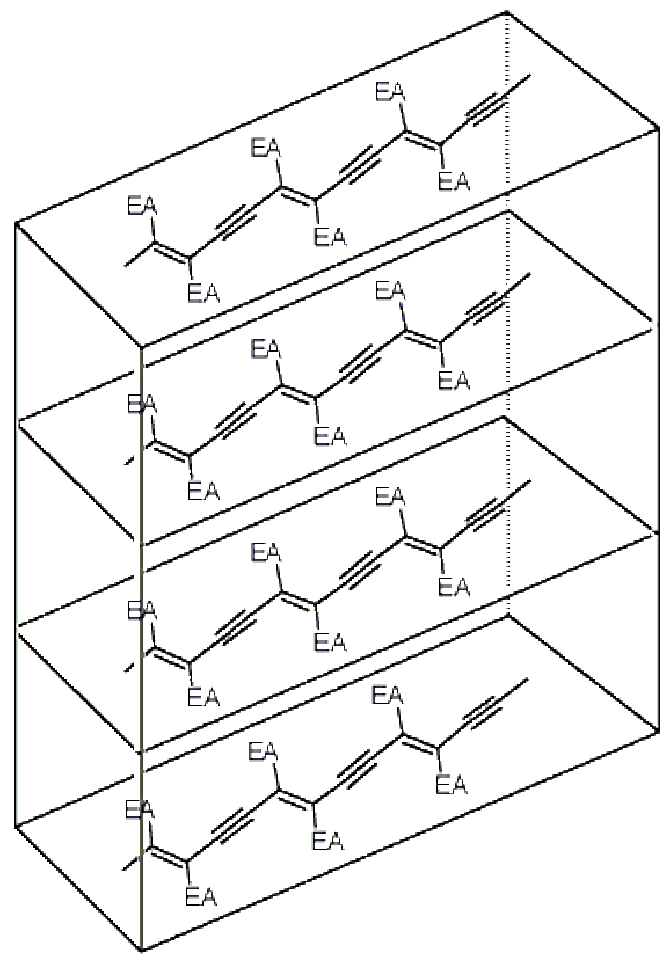Project
Development of materials for organic photovoltaic devices
This can be done by roughly three types of solar cells: fully inorganic ones (e.g. the silicon solar cells that one can occasionally see on roofs), hybrid inorganic/organic solar cells, and fully organic solar cells. Our contribution to this field is to investigate classes of materials that could be of interest for the latter type of solar cells. In this way we make it hard on ourselves, as slight modifications of materials that work “okayish” yield easier results. The disadvantage is that such an approach limits the search for the best materials to well-known classes of materials, while it is not known whether these materials are in fact the best or close to the best.
Our efforts in this area revolve around the concept of order: we are interested in making highly ordered electron donor materials derived from polydiacetylene, and on the other hand completely disordered/amorphous n-type materials, based on aromatic diimides.
In this field we collaborate with many other groups within the framework of the Dutch Polymer Institute.
Donors
We have been interested in covalent coupling of electron acceptors to polydiacetylenes. (Macromolecules 1999, Macromolecules 2000). This work involves organic synthesis, determination of the presence or absence of ordering and the length scales thereof, and delineation of the photophysical properties and charge mobility. While polydiacetylenes are well studied, no reasonable working model exists to predict its electronic structure or its color. In order to make a prediction, we have synthesized oligodiacetylenes (Tetr. Lett. 2003) and photophysical and high-level computational studies are being carried out.
Acceptors
For organic solar cells comparatively good electron donors are known whereas development of a good acceptors has progressed somewhat less. A class of highly interesting electron acceptor is formed by aromatic diimides. We have studied the liquid crystallinity and conductivity of several highly ordered perylene diimides (JACS 2000). Our present research in this field concerns increasing the solubility and getting uniform films with a good miscibility with a donor material. For this purpose we synthesize new classes of n-type material in which the chromophores are arranged in a tetrahedral geometry. By this way we are able to obtain uniform films without any aggregation.

Publications:
Helma M. Barentsen, Marinus van Dijk, Peter Kimkes, Han Zuilhof, and Ernst J. R. Sudhölter, Macromolecules 2000, 32, 1753-1762Helma M. Barentsen, Marinus van Dijk, Han Zuilhof, and Ernst J. R. Sudhölter Macromolecules 2000, 33, 766-77
Tom J. Savenije and John M. Warman, Helma M. Barentsen, Marinus van Dijk, Han Zuilhof, and Ernst J. R. Sudhölter, Macromolecules 2000, 33, 60-66
Michael Polhuis, Cindy C. J. Hendrikx, Han Zuilhof and Ernst J. R. Sudhölter, Tetrahedron Letters, 44 (2003) 899–901
Corien W. Struijk, Alexander B. Sieval, Jarno E. J. Dakhorst, Marinus van Dijk, Peter Kimkes, Rob B. M. Koehorst, Harry Donker, Tjeerd J. Schaafsma, Stephen J. Picken, Anick M. van de Craats, John M. Warman, Han Zuilhof, and Ernst J. R. Sudhölter, J. Am. Chem. Soc. 2000, 122, 11057-11066
Current co-workers: Cindy Hendrikx, Ganesan Palaniswamy, Gregor Pilzak, Kitty van Gruijthuijzen.